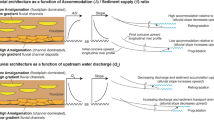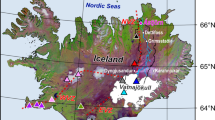Abstract
Late Cenozoic cooling and changes in glacial–interglacial cycle tempo are thought to increase global rates of erosion starting ~3 million years ago (Ma). Bedrock rivers set rates and patterns of erosion in most landscapes, but constraints on river response to late Cenozoic climate change remain elusive. Here, we determine cosmogenic isotope and luminescence ages of well-preserved bedrock terraces along the Fortymile River (Yukon River basin) to reconstruct an ~5 Myr history of fluvial adjustment to late Cenozoic climate and Yukon River headwater capture at 2.6 Ma. Post-capture Yukon River downcutting lowered the Fortymile River outlet, forcing subsequent bedrock incision throughout the Fortymile basin in two pulses, from 2.4 to 1.8 Ma and at ~1 Ma. These pulses of incision disrupted longer intervals of slow river channel sedimentation under near-consistent climate forcing from 4.8 to 2.4 Ma and from 1.8 to ~1 Ma. The Fortymile River delivers sediment to the Bering Sea, where provenance and accumulation rate changes since 4.3 Ma match observed variations in incision. Our results link alluviation and incision to late Cenozoic climate steadiness and change, respectively, and support the hypothesis that climate-forced changes in precipitation and runoff fundamentally control the pace of river incision and landscape erosion.
This is a preview of subscription content, access via your institution
Access options
Access Nature and 54 other Nature Portfolio journals
Get Nature+, our best-value online-access subscription
$29.99 / 30 days
cancel any time
Subscribe to this journal
Receive 12 print issues and online access
$259.00 per year
only $21.58 per issue
Buy this article
- Purchase on Springer Link
- Instant access to full article PDF
Prices may be subject to local taxes which are calculated during checkout



Similar content being viewed by others
Data availability
The cosmogenic and luminescence data that support the findings of this study are available in the supplementary materials and through the US Geological Survey Alaska Science Center Science Portal with the identifier https://doi.org/10.5066/P9XVMTAK. The IfSAR-based Alaska digital elevation models and the National Elevation Dataset digital elevation model of Yukon, Canada that support the findings of this study are available by searching https://earthexplorer.usgs.gov.
References
Whipple, K. X. Bedrock rivers and the geomorphology of active orogens. Annu. Rev. Earth Planet. Sci. 32, 151–185 (2004).
Perron, J. T. Climate and the pace of erosional landscape evolution. Annu. Rev. Earth Planet. Sci. 45, 561–591 (2017).
Pazzaglia, F. J. in Treatise on Geomorphology (eds. Shroder, J.F. & Wohl, E.) 379–412 (Academic, 2013).
Burbank, D. W. et al. Bedrock incision, rock uplift and threshold hillslopes in the northwestern Himalayas. Nature 379, 505–510 (1996).
Pan, B. et al. A 900 ky record of strath terrace formation during glacial–interglacial transitions in northwest China. Geology 11, 957–960 (2003).
Yang, R., Willett, S. D. & Goren, L. In situ low-relief landscape formation as a result of river network disruption. Nature 520, 526–529 (2015).
Whipple, K. X., DiBiase, R. A., Ouimet, W. B. & Forte, A. M. Preservation or piracy: diagnosing low-relief, high-elevation surface formation mechanisms. Geology 1, 91–94 (2017).
Hancock, G. S. & Anderson, R. S. Numerical modeling of fluvial strath-terrace formation in response to oscillating climate. Geol. Soc. Am. Bull. 9, 1131–1142 (2002).
Finnegan, N. J., Schumer, R. & Finnegan, S. A signature of transience in bedrock river incision rates over timescales of 104–107 years. Nature 505, 391–394 (2014).
Gallen, S. F., Pazzaglia, F. J., Wegmann, K. W., Pederson, J. L. & Gardner, T. W. The dynamic reference frame of rivers and apparent transience in incision rates. Geology 43, 623–626 (2015).
Molnar, P. & England, P. Late Cenozoic uplift of mountain ranges and global climate change: chicken or egg? Nature 346, 29–32 (1990).
Peizhen, Z., Molnar, P. & Downs, W. R. Increased sedimentation rates and grain sizes 2–4 Myr ago due to the influence of climate change on erosion rates. Nature 410, 891–897 (2001).
Molnar, P. Late Cenozoic increase in accumulation rates of terrestrial sediment: how might climate change have affected erosion rates? Annu. Rev. Earth Planet. Sci. 32, 67–89 (2004).
Herman, F. et al. Worldwide acceleration of mountain erosion under a cooling climate. Nature 504, 423–426 (2013).
Willenbring, J. K. & von Blanckenburg, F. Long-term stability of global erosion rates and weathering during late-Cenozoic cooling. Nature 465, 211–214 (2010).
Willenbring, J. K. & Jerolmack, D. J. The null hypothesis: globally steady rates of erosion, weathering fluxes and shelf sediment accumulation during late Cenozoic mountain uplift and glaciation. Terra Nova 28, 11–18 (2016).
Lisiecki, L. E. & Raymo, M. E. A Pliocene–Pleistocene stack of 57 globally distributed benthic δ18O records. Paleoceanography 20, PA1003 (2005).
Zachos, J., Pagani, M., Sloan, L., Thomas, E. & Billups, K. Trends, rhythms, and aberrations in global climate 65 Ma to present. Science 292, 686–693 (2001).
Wang, Y. H. et al. Millennial- and orbital-scale changes in the East Asian monsoon over the past 224,000 years. Nature 451, 1090–1093 (2008).
Godard, V., Tucker, G. E., Fisher, G. B., Burbank, D. W. & Bookhagen, B. Frequency‐dependent landscape response to climatic forcing. Geophys. Res. Lett. 40, 859–863 (2013).
Ferrier, K. L., Huppert, K. L. & Perron, J. T. Climatic control of bedrock river incision. Nature 496, 206–209 (2013).
Finnegan, N. J., Sklar, L. S. & Fuller, T. K. Interplay of sediment supply, river incision, and channel morphology revealed by the transient evolution of an experimental bedrock channel. J. Geophys. Res. 112, F03S11 (2007).
Sklar, L. S. & Dietrich, W. E. Sediment and rock strength controls on river incision into bedrock. Geology 29, 1087–1090 (2001).
Horikawa, K. et al. Pliocene cooling enhanced by flow of low-salinity Bering Sea water to the Arctic Ocean. Nat. Commun. 6, 7587 (2015).
Tempelman-Kluit, D. Evolution of physiography and drainage in southern Yukon. Can. J. Earth Sci. 9, 1189–1203 (1980).
Duk-Rodkin, A., Barendregt, R. W., White, J. M. & Singhroy, V. H. Geologic evolution of the Yukon River: implications for placer gold. Quat. Int. 82, 5–31 (2001).
Duk-Rodkin, A. et al. Timing and extent of Plio–Pleistocene glaciations in north-western Canada and east-central Alaska. Dev. Quat. Sci. 2, 313–345 (2004).
Bender, A. M., Lease, R. O., Corbett, L. B., Bierman, P. & Caffee, M. W. Ongoing bedrock incision of the Fortymile River driven by Pliocene–Pleistocene Yukon River capture, eastern Alaska, USA, and Yukon, Canada. Geology 46, 635–638 (2019).
Hidy, A. J., Gosse, J. C., Froese, D. G., Bond, J. D. & Rood, D. H. A latest Pliocene age for the earliest and most extensive Cordilleran ice sheet in northwestern Canada. Quat. Sci. Rev. 61, 77–84 (2013).
Whipple, K. X. Fluvial landscape response time: how plausible is steady-state denudation? Am. J. Sci. 4–5, 313–325 (2001).
Weber, F. R. in Glaciation in Alaska, The Geologic Record (eds. Hamilton, T. D., Reed, K. M. & Thorson, R. M.) 79–98 (Alaska Geological Society, 1986).
Bacon, C. R., Dusel-Bacon, C., Aleinikoff, J. N. & Slack, J. F. The Late Cretaceous Middle Fork caldera, its resurgent intrusion, and enduring landscape stability in east-central Alaska. Geosphere 10, 1432–1455 (2014).
Dusel-Bacon, C., Bacon, C. R., O’Sullivan, P. B. & Day, W. C. Apatite fission-track evidence for regional exhumation in the subtropical Eocene, block faulting, and localized fluid flow in east-central Alaska. Can. J. Earth Sci. 53, 260–280 (2016).
Foster, H. L., Weber, F. R., Forbes, R. B. & Brabb, E. E. in Arctic Geology (ed. Pitcher, M. G.) 388–395 (AAPG, 1973).
Forte, A. M. & Whipple, K. X. The Topographic Analysis Kit (TAK) for TopoToolbox. Earth Surf. Dyn. 7, 87–95 (2019).
Schwanghart, W. & Scherler, D. TopoToolbox 2–MATLAB-based software for topographic analysis and modeling in Earth surface sciences. Earth Surf. Dyn. 2, 1–7 (2014).
Balco, G. & Rovey, C. W. An isochron method for cosmogenic-nuclide dating of buried soils and sediments. Am. J. Sci. 308, 1083–1114 (2008).
Erlanger, E. D., Granger, D. E. & Gibbon, R. J. Rock uplift rates in South Africa from isochron burial dating of fluvial and marine terraces. Geology 40, 1019–1022 (2012).
Rittenour, T. M. Luminescence dating of fluvial deposits: applications to geomorphic, palaeoseismic and archaeological research. Boreas 37, 613–635 (2008).
Balco, G., Stone, J. O., Lifton, N. A. & Dunai, T. J. A complete and easily accessible means of calculating surface exposure ages or erosion rates from 10Be and 26Al measurements. Quat. Geochronol. 3, 174–195 (2008).
Bierman, P. & Steig, E. J. Estimating rates of denudation using cosmogenic isotope abundances in sediment. Earth Surf. Process. Landf. 21, 125–139 (1996).
Whipple, K. X. & Tucker, G. E. Implications of sediment‐flux‐dependent river incision models for landscape evolution. J. Geophys. Res. 107, ETG-3-1–ETG-3-20 (2002).
Montgomery, D. R. & Brandon, M. T. Topographic controls on erosion rates in tectonically active mountain ranges. Earth Planet. Sci. Lett. 201, 481–489 (2002).
Corbett, L. B., Bierman, P. R. & Rood, D. H. An approach for optimizing in situ cosmogenic 10Be sample preparation. Quat. Geochronol. 33, 24–34 (2016).
Nishiizumi, K. Preparation of 26Al AMS standards. Nucl. Instrum. Methods Phys. Res. B 223–224, 388–392 (2004).
Nishiizumi, K. et al. Absolute calibration of 10Be AMS standards. Nucl. Instrum. Methods Phys. Res. B 258, 403–413 (2007).
Gosse, J. C. & Phillips, F. M. Terrestrial in situ cosmogenic nuclides: theory and application. Quat. Sci. Rev. 14, 1475–1560 (2001).
Wallinga, J. & Duller, G. A. T. The effect of optical absorption on the infrared stimulated luminescence age obtained on coarse-grain feldspar. Quat. Sci. Rev. 19, 1035–1042 (2000).
Galbraith, R. F. & Roberts, R. G. Statistical aspects of equivalent dose and error calculation and display in OSL dating: an overview and some recommendations. Quat. Geochronol. 11, 1–27 (2012).
Huntley, D. J. & Lamothe, M. Ubiquity of anomalous fading in K-feldspars and the measurement and correction for it in optical dating. Can. J. Earth Sci. 38, 1093–1106 (2001).
Guérin, G., Mercier, N. & Adamiec, G. Dose-rate conversion factors: update. Ancient TL 29, 5–8 (2011).
Mejdahl, V. Thermoluminescence dating: beta-dose attenuation in quartz grains. Archaeometry 21, 61–72 (1979).
Rees-Jones, J. Optical dating of young sediments using fine-grain quartz. Ancient TL 13, 9–14 (1995).
Bender, A. M. Fortymile River Cosmogenic Isotope and Luminescence Data Collected 2016–2019 (USGS, 2020); https://doi.org/10.5066/P9XVMTAK
Acknowledgements
We thank W. H. Craddock and C. Bacon for reviews; M. L. Miller and J. Slate for editorial support; J. V. Jones for US Geological Survey project support; Vertical Solutions Helicopters for field support; and A. Neely and L. Williamson for lab assistance. Any use of trade, firm or product names is for descriptive purposes only and does not imply endorsement by the US Government. Funding was provided by the USGS Mineral Resources Program, and by the National Science Foundation under grant number EAR-1735676 to P.R.B. and grant number EAR-0919759 to M.W.C.
Author information
Authors and Affiliations
Contributions
A.M.B. and R.O.L. conceptualized the research and conducted field investigations; A.M.B., L.B.C., P.R.B., M.W.C. and T.M.R. conducted laboratory investigations; A.M.B., L.B.C. and T.M.R. curated and formally analysed the data; R.O.L. and P.R.B. acquired funding and resources; A.M.B. wrote the paper and developed figures; all authors contributed to editing and revision.
Corresponding author
Ethics declarations
Competing interests
The authors declare no competing interests.
Additional information
Peer review information Primary Handling Editor: James Super.
Publisher’s note Springer Nature remains neutral with regard to jurisdictional claims in published maps and institutional affiliations.
Supplementary information
Supplementary Information
Supplementary Figs. 1–12.
Supplementary Data
Cosmogenic and luminescence data that support the research.
Rights and permissions
About this article
Cite this article
Bender, A.M., Lease, R.O., Corbett, L.B. et al. Late Cenozoic climate change paces landscape adjustments to Yukon River capture. Nat. Geosci. 13, 571–575 (2020). https://doi.org/10.1038/s41561-020-0611-4
Received:
Accepted:
Published:
Issue Date:
DOI: https://doi.org/10.1038/s41561-020-0611-4
This article is cited by
-
Stepwise increased spatial provenance contrast on the Chinese Loess Plateau over late Miocene-Pleistocene
Communications Earth & Environment (2023)
-
Abandonment of ancient cities near the Salawusu River valley, China, triggered by stream capture
Communications Earth & Environment (2022)



